Servicios Personalizados
Articulo
Indicadores
Links relacionados
-
 Citado por Google
Citado por Google -
 Similares en Google
Similares en Google
Compartir
Yesterday and Today
versión On-line ISSN 2309-9003
versión impresa ISSN 2223-0386
Y&T no.11 Vanderbijlpark ene. 2014
HANDS-ON-DISCUSSIONS
Inspiring learners beyond the classroom walls: The what, why, who, where and wow for organising curriculum - based "History tours"
Gordon J Brookbanks
Westerford High School gordonbrookbanks@gmail.com
ABSTRACT
Any educator, passionate about his / her discipline, works on techniques and methods to inspire learners. If such an educator 'gets the recipe' right, it will translate into learners applying themselves to the subject and both their understanding of content and acquisition of required skills will increase exponentially. This will impact positively on assessment results. Buy-in for the subject will increase as the inspired learners become the most influential marketing agent for the subject. This holds true especially with the teaching of History. One technique and method which can serve to inspire learners beyond the walls of the classroom and confines of the covers of a text book, is their experience of grade- and curriculum-relevant excursions. Due to perceived organisational hurdles, departmental obstacles, and the consequences of an educator's in loco parentis responsibility, many educators would not consider excursions as an option, let alone overseas excursions. In this article, an educator shares his experience in the organising of Grade 12 curriculum-based "History Tours" for his learners, and provides the what, why, who, where, when and how for organising such tours.
Keywords: Inspiring; Overseas excursions; History tours; Curriculum-based; Learners; Educators.
A dream becomes a reality
Turning a personal and class "dream" into a reality started with making a comment to my Grade 9 class in 2005, during a discussion in Holocaust History, and having engaged over statements made by the former Commander of Auschwitz KL, Rudolf Hoëss. I commented on the importance of hearing voices of the past and suggested that their walking through Auschwitz would open their minds to a far deeper understanding of the lessons for humanity which we derive from studying Holocaust History. The learners did not forget the suggestion. The following year, while studying the "Quest for Liberty" theme in the Grade 10 curriculum, they asked "When are we going overseas?". Being true to my word, I took them on an excursion "overseas" - we visited Robben Island! Not surprisingly, this did not meet their expectation, and so the planning for our "overseas" history tour began.
We undertook the tour during the April 2008 holidays of their Grade 12 year. The curriculum-based focus of our inaugural "history tour" was both Holocaust- and Cold War history, and served to inform all aspects of our itinerary. The impact of this tour has been such, that in December 2014 the 8th History Tour offered to our Grade 12 learners, will be visiting the People's Republic of China (PRC). The size of our groups travelling each year has increased as the history tour developed into what is now an annual event. The initial group was comprised of 18 learners' and in December 2014 we will be travelling with 53 learners. We have heard this will be the first history focussed group of learners the PRC has received. The choice for visiting the PRC is to enrich the learners' understanding of the period of the Ming Dynasty (their Grade 10 curriculum), engage with the early training of Umkhonto we Sizwe combatants in the PRC (their Grade 11 curriculum), and more specifically developments in the PRC during both the civil war, the creating of the PRC in 1949 and subsequent internal and foreign policies adopted (their Grade 12 curriculum).
The What: A grade-specific, curriculum-based history tour
Through offering an overseas History Tour, learners enjoy the inevitable benefit of personal growth through exposure to foreign cultures, and learn important life-skills. Many learners have never been on an aeroplane, let alone travelled outside the borders of South Africa, so their knowledge of working with passports, boarding passes, foreign currencies, itineraries, street maps, and different languages and food develops an independence and appreciation of "the other". The tour we initially offered has become an annual event, and is based on a grade-specific (Grade 12) and curriculum-based focus (primarily Cold War History), through which the learners' understanding of what they are learning in the classroom is enriched immeasurably.
The template for our subsequent tours is informed by the experience and impact the 2008 tour had on our learners, and the appreciation expressed by their parents. Examples of comments by parents after previous tours, give an indication of the value they attach to the experience gained by their learnerren:
... it is an experience she will cherish for always... teaching is so much more than what happens in the classroom. Know that you have made a difference. Thank you.
(Parents, Central and Eastern Europe, April 2008)
Thanks to you both for a FANTASTIC live-changing tour for our young adults. (Daughter) is exhausted but exhilarated and I am loving all the stories...
(A mother, Vietnam and Cambodia, December 2011)
Thank you so much for organising the most wonderful trip to Vietnam! (Daughter) loved every minute of it and learned so much - not only about Vietnam and Cambodia and their history! It seemed to be the most action packed, dynamic trip imaginable and everything seemed to go so smoothly ... You really have instilled a deep love for history in her.
(Parents, Vietnam and Cambodia, December 2011)
It has been profoundly meaningful to us that (son) has been able to visit the historical sites of the holocaust and to have learnt, through visiting these places, what actually took place. It affected him deeply on an emotional level while enabling a huge amount of learning and understanding. He has absorbed so much - and at the same time had a lot of fun...
(Parents, Central and Eastern Europe, June 2012)
Firstly a huge thank you for ensuring that the kids arrived back safely and in one piece and for being such an incredible guide on this once in a lifetime opportunity for most. Your chronicles have given us a real sense of what the learnerren were exposed to and a chance for us to vicariously journey alongside them - the kind of detail you provided would take months to be forthcoming, if ever, as everyone tends to pick up and carry on with their lives in CT. We are grateful that (learner) was able to experience all that the History tour had to offer even if it was overwhelming at times. The memories will be therefor a long time. Thank You.
(Parents, Central and Eastern Europe, June 2013)
These responses from parents are important to note. The tour itself, and therefore the learners' experience, would not become a reality unless the parents / guardians see the value in the tour, both in terms of enhancing their learnerren's education and the personal growth the learner experiences.
Parents travel vicariously with their learnerren. That is understandable, particularly to educators who are themselves parents. In all communication with the learners as they were prepared intellectually for the tour, both in terms of curriculum-based content and the relevance of sites they would visit, parents were similarly informed. On the tour, a "Daily Journal" of what the learners experienced, with photographs, were e-mailed through to the parents. On visiting potentially emotionally traumatic sites such as Auschwitz, learners were encouraged to document their "personal reflections" as part of a "debriefing". These consolidated reflections were e-mailed through to the parents. Learners are encouraged to express themselves in a form in which they are most comfortable.
Educators are themselves affected by what they see and experience. An example of a personal reflection after visiting Sachsenhausen Concentration Camp (Berlin, 2009) was communicated in the form of a poem by an accompanying educator:
Sachsenhausen is in Germany: There were no 'death camps', only concentration camps in Germany. ONLY concentration camps?
Human beings died at Sachsenhausen.
Humans died.
From starvation. Years of it.
People were drowned in the foot "baths". After 400 at a time were regularly crowded into a tiny washroom together.
Hung from gallows.
Shot.
So it was an occasional death camp? Periodically? Irregularly?
No. Humans died there.
While birds were singing? The same kind of birds we heard on our approach. Birds singing? Singing? Or did the birds' song die too? Did they flee from the stench?
Because there was Zylclon B at Sachsenhausen too.
Zylclon B?
Yes. And we still teach: No death camps in Germany, ONLY concentration camps.
Concentrated daily degradation and deprivation.
And death.
And death.
I couldn't walk anymore.
I couldn't walk anymore.
I stopped. Lay down. My bag was too heavy.
And yet, later, much later, I picked up my bag again - later, back at the hostel. My bag had not been heavy at all.
TS Eliot said: Mankind cannot bear too much reality.
There, at Sachsenhausen, the reality had been too much. The reality was Death, over-present, omnipotent.
I had been ready for a camp, but not for the death. In Germany"
(Educator, Central and Eastern Europe, 2009)
The Why and Who of travel
When travelling to Central and Eastern Europe the itinerary has started in Berlin. It is a city which is extraordinary in terms of being able to see and experience both Holocaust- and Cold War History around every corner. Various "characters" which learners had been exposed to during their study of history serve to inform how the itinerary and sites to visit are identified. A good example is the person and actions of Reinhard Heydrich. On arrival in Berlin the group visited the Typography of Terror site, the former HQ of the Gestapo and office of Reinhard Heydrich. They then travelled to the western suburbs of Berlin to visit the Wannsee Villa, where they sat around the conference table at which Heydrich and his invitees drafted the Wannsee Protocols for the "Final Solution of the Jewish Question". On leaving Berlin, the group travelled to the Czech Republic where they visited the Terezin Ghetto and Lidice, the site where an entire village was destroyed in retribution for the assassination of Heydrich. We were moved by the life size memorial commemorating the learnerren killed during the Lidice tragedy. Travelling through to Prague, they saw the site of Heydrich's assassination and subsequent statue built in memory of the partisans responsible for his assassination. Finally, on entering Poland, we visited both Auschwitz 1 and Auschwitz-Birkenau, the epicentre for the implementation of the "Final Solution".
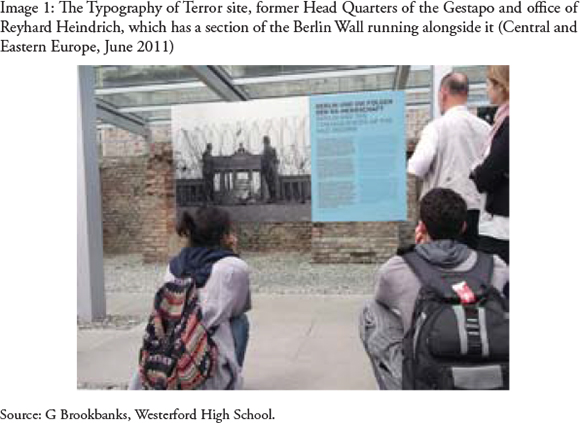
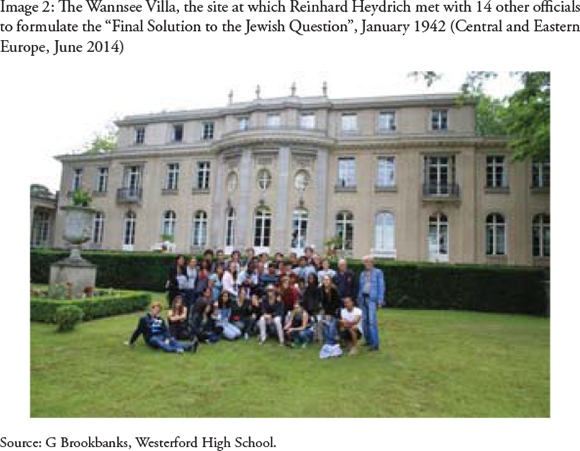
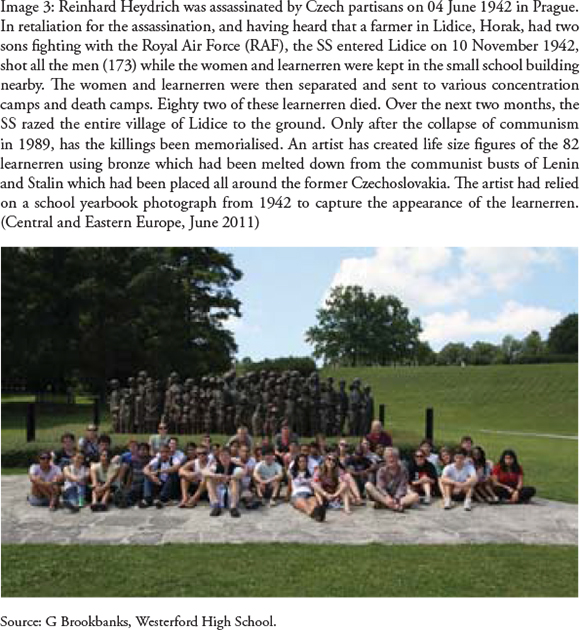
Travelling through these parts of Eastern Europe, the learners were constantly reminded of the individual former Soviet satellites' experience of Soviet domination and Red Army occupation. For example, walking through Wenceslas Square in Prague, learners' revisit the surrounding of learners by Red Army tanks during the Prague Spring of 1968 and discuss the impact of the Brezhnev Doctrine on Soviet Satellite states, and Czechoslovakia in particular. While all learners study, experience and are exposed to Holocaust History in their Grade 9 curriculum, our decision to restrict the tour to Grade 12 learners was based on our understanding that learners in Grade 9 may be intellectually and emotionally mature enough to engage with Holocaust History in the classroom, but do not necessarily have the intellectual and emotional maturity to take that understanding and "walk through a gas chamber in Auschwitz".
When and Where to go?
The first tour in 2008 travelled in the April holidays. In recent years the April school holiday is often only a week. A week is far too short a period to undertake such a tour, especially as Departmental policy does not permit loss of school days, despite the added-educational value of such a tour. Subsequent tours to Eastern Europe which, in addition to those countries previously mentioned, have included Hungary, Lithuania, Latvia, Estonia, and the Russian Federation, have all travelled in the June holidays (summer in Eastern Europe). Some tours have travelled to South East Asia (Vietnam and Cambodia) in the December holidays of the learners Grade 11 year (winter in South East Asia). Summer in Vietnam, where it rains most days, is very hot and humid, which makes travel uncomfortable. In preparation we taught the Cold War theme and Case Studies of their Grade 12 curriculum in the fourth term of their Grade 11 year. This enabled the learners to have the theoretical background and context prior to departure.
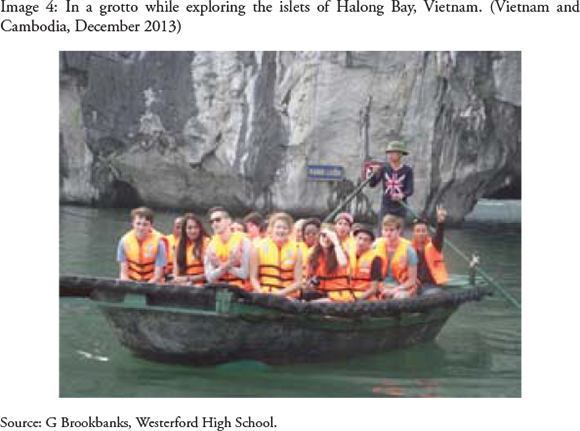
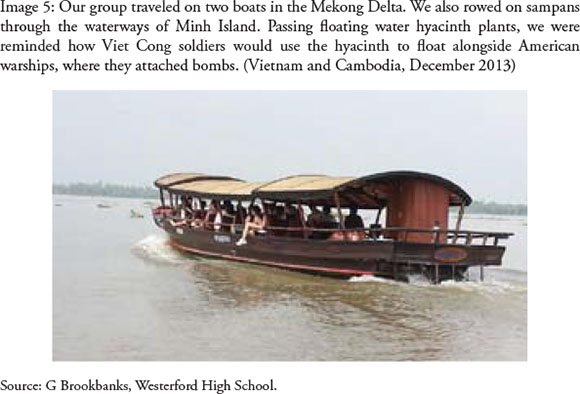


The greater proportion of sites visited enable the learners to see, feel, smell, touch, and hear aspects of their curriculum, and delve deeper into an understanding of what they have been exposed to through their textbook and classroom environment. As much as the purpose of the tour dictates the itinerary, it does not exclude the learners seeing traditional "tourist book sights", experiencing local cuisine, and having fun. Our December 2014 tour where we intend skiing alongside the Great Wall of China is an example of the creative organising balance required in developing a curriculum-based itinerary which is age appropriate.
The How: Don't get enmeshed in the challenges, see the opportunities, and do!
We apply a "ten step process" which may assist other educators to turn their dreams into a reality:
Step One
Get clarity in your own mind as to which aspect of the curriculum, and for which grades, you intend to construct a history tour. If you intend working with a cross-section of grades (and therefore ages), it will pose challenges as to how you meet your intended objective.
Step Two
Informed by the curriculum, focus on the countries you would like your learners to visit, identify the most practical time of the year and the period of time for your intended tour. Formulate a "draft itinerary". Do not recreate the wheel - very successful tours have taken place in recent years, by different schools. Access their itineraries, and then tweak the itinerary to meet your explicit needs and objectives.
Step Three
With a draft itinerary in hand, an estimated costing is now required. Engage with a number of different travel agents to determine an "all inclusive" per learner costing based on the time frame for your proposed tour and envisaged itinerary. All costs for a participating learner have to be determined. It is this all-inclusive "price tag" which parents / guardians would have to consider if they were to commit to the proposed tour. As a rule of thumb, the costs for accompanying teachers are built into the all-inclusive "price-tag" which is only feasible if the interested numbers are based on 1 teacher per 12 to 15 learners. Keep in mind, most international airlines, hotels / youth hostels, transport companies, and restaurants provide complimentary tickets, accommodation, or food for an accompanying educator, depending on the size of the group. The all-inclusive price tag per learner will exclude pocket money and any visa application costs which specific passport holders may require.
Step Four
With your grade-specific subject-curriculum focus determined, a basic itinerary formulated and an estimated costing per interested learner, it is now time to present the idea of the proposed history tour to your Head of Department, Principal and Senior Management Team (SMT) to get approval.
Step Five
Having received approval, the detail and cost is presented to your learners. Prepare a letter addressed to their parents / guardians in which you explain the purpose of the tour, give a summarised version of the itinerary and related dates, and the estimated cost per learner. The letter could include a reply slip with a due date for reply, in which the parent / guardian expresses an interest in the tour. Remember to include space for the learner's name, class details as well as parent contact details such as phone number and e-mail address. You could include your own e-mail address should parents prefer to contact you for further detail or to indicate their interest in the proposed tour. The letter to the parent must specify that their completing the reply slip is merely an "expression of interest", but in returning it they must undertake to make application for a passport and an Unabridged Birth Certificate (in the case of RSA passport holders under 18 years of age) which is a process that takes time.
Step Six
Capture the data from the rely slips on an Excel spreadsheet (labelled "interested learners") using the following minimum columns: Surname, First Name, Class, Gender (where relevant) and, parents' contact detail. At this stage two processes unfold:
- A list of interested learners is provided to the travel agent (you are now working in tandem with them to ensure that your tour becomes a reality); and
- Based on the estimated cost per learner a payment schedule in consultation with the travel agent has to be formulated. Your travel agent will advise you as to when deposits for accommodation, flights, etc, have to be made, dates by which visa applications have to be submitted as well as any other related administrative "benchmarks" which need to be met. Only then does your second letter of communication get distributed, via e-mail and/or hard copy to those parents / guardians who have made an "expression of interest". This communication will include the detailed payment schedule / benchmark dates and include the banking details of the travel agent. The first date and amount for payment is a non-refundable deposit and by implication a commitment to the tour. All payments should be made directly to the travel agent so as not to burden the organisational educator or the school's bursar with having to administer the process.
Step Seven
After the due date for the payment of the initial non-refundable deposit, the travel agent will provide you with an Excel spreadsheet of all those committed to the tour, or the spreadsheet can be uploaded onto a platform such as Google Docs or Dropbox which the travel agent gives you access to. You now have confirmation as to how many learners are part of your tour and, based on the "1 teacher: 12 to 15 learner" ratio, you will now be in a position to determine how many educators can be accommodated on the tour with you, in a supervisory role. It is suggested that the nomination of additional teachers to your tour be undertaken by your Head of Department or Principal, to prevent being drawn into unnecessary organistational politics.
Step Eight
It is advisable, as each due date for payment approaches, that you draft a letter of communication for dissemination by the travel agent to the learners and their parents / guardians in which you make reference to an aspect of preparation for your tour. It will serve to both generate excitement amongst learners and parents / guardians alike, and serve as a reminder as to what payment is due and when.
Step Nine
With about six weeks to go before your departure date it is important to host a final briefing meeting with participating learners on your tour, their parents / guardians, accompanying educators and the organising travel agent. During this final briefing meeting what should / should not be packed is highlighted, purchase procedures of foreign exchange for pocket money / breakage deposits at hotels clarified, meeting procedures at departing venues explained and any behaviour guidelines and expectations addressed. The travel agent will address any administrative processes still outstanding, such as visa applications.
Step Ten
On the date of departure, meet your group at the designated departure venue and give time for all necessary goodbyes before leaving for an experience of a lifetime!
Having arrived at the airport to meet your group for departure your first challenge is to ensure all learners have arrived. Rather than having to rely on ticking off each name against a list, we soon learnt to allocate everyone to a sub-group with a designated number. On leaving restaurants, getting off metro trains, and exiting museums the group is instructed to break into sub-groups where they quickly count off their numbers. Within seconds you know who is missing and we found a healthy competition soon developed between the sub-groups as to who could count-off quickest.
On our return from a tour learners are given the responsibility of writing articles for publication in our school newsletter and year book, and collating photographs for distribution amongst the group. This serves a number of purposes. Learners themselves love to reminisce and seeing their tour in print rekindles wonderful memories. The audience which has access to both the newsletter and year book are participants for future tours, so they serve as an effective marketing tool.
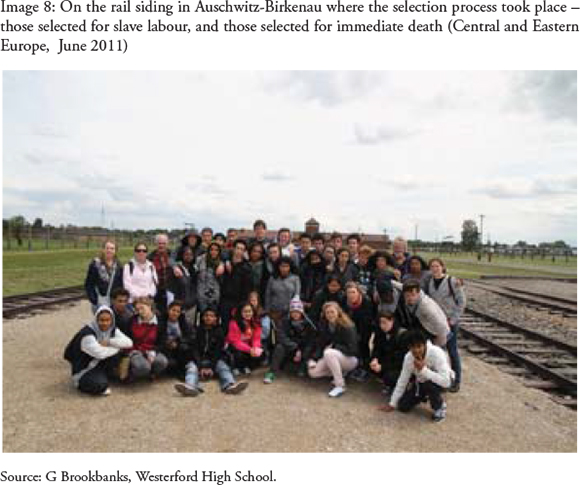
The extent to which the learners benefit from the experience can be heard through their personal reflections on visiting sites associated with their curriculum. Having visited Sachsenhausen Concentration Camp, in Berlin a learner said:
I tried to imagine myself in the camp as a prisoner, but it's humbling to realise I can never truly understand the fear that the prisoners felt. The infirmary stood out as the place I would've feared the most. Being experimented on, and knowing that you will die under extreme pain is scary. The doctors injected dead people's tissue into living people to see if they could be 'cured' of their illness. They castrated men and sterilised everyone against their will. They were treated as rats, vermin. Inhumanity comes in different forms, but Sachsenhausen is a display of the worst type of inhumanity (Anon., Grade 12, Berlin 2010).
After visiting the Terezin Ghetto, in the Czech Republic a learner commented:
Extremely poweful stories and images that only make the Holocaust a more real event, and not just something from a textbook. Will never be forgotten (Anon., Grade 12, Terezin Ghetto, Czech Rep, 2010).
Personal reflections from learners after visiting Auschwitz 1 and Auschwitz-Birkenau, in Poland include:
I don't really know how to describe how Auschwitz made me feel. I felt absolutely traumatised when I saw the human hair and felt disgusted when I heard that the Commandant's wife described her life next to the camp as 'paradise'. The only word I can think of to describe the feel and atmosphere of that camp is evil (Anon., Grade 12, Auschwitz, Poland, June 2010).
These places weigh on your soul, They pull you down, take your breath away and make you cry until it seems there is no more water in your body. The capability for destruction and the reality of annihilation hits you and you wonder; Where was God? Where was human compassion? The truth is there was no room. There was indifference. There was cruelty. There was insanity. Because there is no other explanation for what happened here (Anon., Grade 12, Auschwitz, Poland, June 2010).
Seeing the place to which my great-grandparents were transported to and subsequently murdered was quite a harrowing experience. I can only be grateful to them for having the foresight to save my grandmother and her siblings. It was, however, interesting to see how efficiently the extermination was carried out, It was, paradoxically, efficiently barbaric (Anon., Grade 12, Auschwitz, Poland, June 2011).
Local is lekken
The History Department of the school at which the writer is employed neither restricts its use of excursions to Grade 12 learners nor overseas travel. When our Grade 9 learners complete their study of Holocaust History, a visit to the Cape Town Holocaust Centre for a half-day programme is organised. The excursion involves a booking with the Cape Town Holocaust Centre over three different days to accommodate the 180 learners in the Grade. A letter explaining the purpose of the excursion and nominal cost of public transport is send out to parents about three weeks before the day. On the day of the excursion the educator meets x2 classes (60 learners) at their school and they walk to the local Metro Rail station to catch the train into town. It is important to note that the experience of travelling as a group into town both by train and walking through the CBD to the Cape Town Holocaust Centre is all part of both the learning experience and fun for the learners. This requires that the educator brief the learners on how to spread out on the platform of the station to ensure that they all get onto the coaches when the train arrives, what happens if a learner does not get onto the train by the time the doors close, how a large group are to walk down pavements in the CBD to ensure other pedestrians are not forced off the pavement, what to do when crossing the road at a traffic light when a large group is involved, how to protect their personal possessions when on the train or walking in the CBD, and the dos and don'ts of behaviour once at the Holocaust Centre. Similarly, our Grade 10 learners have visited the Slave Lodge in the CBD, the Castle, or Robben Island when studying Slavery, Dutch Colonisation of the Cape, or Quest for Liberty themes. Our Grade 11s have visited District Six and the District Six Museum and Houses of Parliament when appropriate to their study of the curriculum.
Forewarned is forearmed
Having undertaken detailed pre-tour planning, being organised and systematic while on tour, the experience for the group should unfold without any significant challenges. In the experience of the writer this has been the case for most of the seven overseas history tours undertaken to date. But gremlins do creep in. It would be remiss of the writer not to share a few hiccups we have had along the way.
Minor challenges include locating restaurants for both lunch and supper big enough to accommodate the size of our group within our learners budget and addressing special dietary requirements of everyone. Lunch can often be resolved through local fast food outlets, which then left us with more in the budget for supper at restaurants.
To save on precious daylight time for touring we often undertook lengthy coach or train travel during the night, which saves on a night's accommodation. This does however mean that we usually arrived at our destination in the early morning, only able to check into the next night's accommodation after 2pm, with no opportunity to shower. What to do with our luggage entailed contacting the hotel or hostel ahead of time to ensure access to their luggage room on our arrival. This arrangement avoids having to pay for luggage storage at the bus terminal or rail station.
Our tour group has always involved learners who are either 17 or 18 years of age. The principle applied has been if one cannot do it, nobody can. Therefore visiting nightclubs, pubs and use of alcohol or cigarettes is not an option. The principled argument is that school rules apply. This remains a challenge. Address what you can on the ground and that which you cannot becomes a disciplinary hearing on your return.
When checking into hotels or hostels the group has to be allocated rooms. On your arrival be prepared. The entire group will be tired, frustrated and wanting to get to a room. Ensure that the entire group, with their bags, congregate in a corner of the reception where they do not create a traffic jam for the entire hotel. Provide the reception with a spreadsheet with names, passport number, date of issue and expiry. Receive all the keys for the rooms and then allocate them to the learners. If not, chaos will reign. Retain a rooming list to ensure you know where each learner is.
When travelling on public transport the organising of tickets for the group can be a challenge. Therefore organise tickets ahead of time and ensure that all the learners are briefed as to the process involved in accessing public transport. We have had the occasion when we have all alighted from a metro, only to find one of our learners was still on the coach when the doors closed. It is not a problem, as long as they all know the procedure to follow under such circumstances (i.e. continue to the next stop, then catch the next metro back one station where we will all be waiting for you).
More heart-palpitating incidents have included a final stop in Istanbul on our way back from Central and Eastern Europe (June, 2011). What an amasing city to visit to experience the merging of the Christian and Muslim worlds! Our final stop en route to the airport for our flight home was the Grand Bazaar, a huge venue with over 40 exits. As the Grand Bazaar was closing at 7pm and we all congregated at the agreed to exit, we found that we were one learner short. Talk about panic, as we could not miss our flight back to South Africa. The entire group was deployed to plough through the Grand Bazaar before the doors closed. There was no sign of the missing learner. The rest of the group was sent back to the coach while the educator negotiated with the local police. We then established, on the group's return to the coach, that the missing learner was waiting for us on the coach. He had got lost in the Grand Bazaar, bumped into the coach driver, and had been directed back to the coach! You can well imagine the thoughts which ran through the educator's mind.
The cherry on the cake of crises would have to be our tour of December 2013. Having completed an exhilarating tour through Vietnam and Cambodia we waited at our hotel in Siem Riep (Cambodia) for the transfer from our hotel to the airport, for the return flight home via Singapore. Once dropped off at the airport we found that that flight time had changed and, although the plane was still on the ground, the gates had closed and we could not board. As the educator responsible for the group, I was now sitting with 48 learners, a missed flight, and we had to get to Singapore within seven hours to get our connecting flight to South Africa. No school, subject-related, or external moderation pressure could ever equate to this challenge! Through diplomatic negotiation between the local travel agent in Siem Riep, his General Manger in Phnom Phen (both cities in Cambodia), the holding company in Ho Chi Minh City (Vietnam), and our own travel agent back in Cape Town we managed to get the group on two different flights from Siem Riep to Singapore, where we all arrived on time for our connecting flight back to South Africa.
The few cited challenges show there is nothing a committed educator cannot see through! No challenge is insurmountable and any problem which may arise can be resolved. It is important for the educator to keep in mind that he / she remain the responsible adult and, irrespective as to how overwhelmed he / she may feel, at no time should the learners see panic on the part of their educator. Just breathe deeply and think! The solution is the issue, not the problem.
Postscript
Excursions offered by imaginative educators, whether they take the learners across the seas or down the road, provide an opportunity for the learner to engage with the curriculum beyond the confines of the classroom and textbook.















